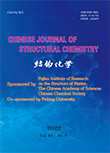Synthesis of Axially Coordinated Cobalt Porphyrin/graphene Oxide Nanocomposite for Enhanced Electrocatalytic CO2 Reduction to CO
YOU Wei-Feng, XU Xiao, CAO Ai-Hui, TAO Zhi-Jie and KANG Long-Tian*
Chin. J. Struct. Chem. 2022, 41, 2203001-2203011 DOI: 10.14102/j.cnki.0254-5861.2011-3247
March 15, 2022
cobalt porphyrin, graphene oxide, axial coordination, carbon dioxide reduction, synergistic catalysis
ABSTRACT
The
electrocatalysts containing cobalt-pyrrolic nitrogen-carbon (Co-N4-C)
moiety for CO2 reduction reaction (CO2RR) have caught much
attention. However, the effects of Co valence state and its synergy with
graphene substrate are not clear yet. In this work, cobalt porphyrin (CoTPP) molecule
with the intrinsic Co-N4-C moiety is successfully combined with
graphene oxide (GO) via three kinds
of liquid-phase methods. The ratio of CoTPP to GO and the valence state of Co
atom are studied to explore their catalysis for CO2RR to CO. It is
found that axially-coordinated Co(III)TPPCl/GO nanocomposites synthesized via a chemical method exhibit better
ability for CO2RR, as compared with Co(II)TPP+GO and/or Co(III)TPPCl+GO
nanocomposites obtained via a
physically mixing way. After optimizing the ratio of CoTPP to GO, the Faradaic
efficiency (FE) is more than 90% for CO2RR to CO between −0.7 and
−0.8 V vs. reversible hydrogen
electrode (RHE) in Co(III)TPPCl/GO75. The synergy between CoTPP and GO and the
effect of Co valence state are systematically investigated, indicating that
their strong interaction plays the key role in electrocatalytic CO2RR.








